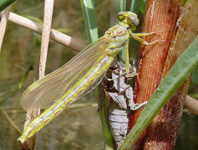Abstract
A new species of a crawling limnomedusa belonging to the genus Gonionemus (Hydrozoa: Limnomedusae: Olindiidae) was collected from the brown alga Cystophora monilifera in an intertidal rock pool in Western Port, Victoria, Australia. The new species is described and compared with the three known species of Gonionemus. The mitochondrial DNA barcode markers cytochrome oxidase I and 16S rRNA were sequenced and compared to sequences from other olindiid species. The sequencing results corroborate the morphological findings.
References
Agassiz, A. (1862) The Acalephan of fauna the southern coast of Massachusetts (Buzzards Bay). Proceedings of the Boston Society of Natural History, 8, 224–226.
Arai, M.N. & Brinckmann-Voss A. (1980) Hydromedusae of British Columbia and Puget Sound. Canadian Bulletin of Fisheries and Aquatic Sciences, 204, 1–192.
Bakker, C. (1980) On the distribution of Gonionemus vertens A. Agassiz (Hydrozoa, Limnomedusae), a new species in the eelgrass beds of Lake Grevelingen (SW Netherlands). Aquatic Ecology, 14 (3), 186–195.
https://doi.org/10.1007/BF02260120Bucklin, A., Steinke, D. & Blanco-Bercial, L. (2011) DNA barcoding of marine metazoa. Annual Review of Marine Science, 3, 471–508.
https://doi.org/10.1146/annurev-marine-120308-080950Collins, A.G., Bentlage, B., Lindner, A., Lindsay, D., Haddock, S.H., Jarms, G., Norenburg, J.L., Jankowski, T. & Cartwright, P. (2008) Phylogenetics of Trachylina (Cnidaria: Hydrozoa) with new insights on the evolution of some problematical taxa. Journal of the Marine Biological Association of the UK, 88, 1673–1685.
https://doi.org/10.1017/S0025315408001732Collins, A.G., Winkelmann, S., Hadrys, H. & Schierwater, B. (2005) Phylogeny of Capitata and Corynidae (Cnidaria, Hydrozoa) in light of mitochondrial 16S rDNA data. Zoologica Scripta, 34, 91–99.
https://doi.org/10.1111/j.1463-6409.2005.00172.xCunningham, C.W. & Buss, L.W. (1993) Molecular evidence for multiple episodes of paedomorphosis in the family Hydractiniidae. Biochemical Systematics and Ecology, 21 (1), 57–69.
https://doi.org/10.1016/0305-1978(93)90009-GDayrat, B. (2005) Towards integrative taxonomy. Biological Journal of the Linnean Society, 85 (3), 407–415.
https://doi.org/10.1111/j.1095-8312.2005.00503.xFolmer, O., Black, M., Hoeh, W., Lutz, R. & Vrijenhoek, R. (1994) DNA primers for amplification of mitochondrial cytochrome c oxidase subunit I from diverse metazoan invertebrates. Molecular Marine Biology and Biotechnology, 3 (5), 294–299.
https://doi.org/10.1007/s10530-015-1019-8Govindarajan, A.F. & Carman, M.R. (2016) Possible cryptic invasion of the Western Pacific toxic population of the hydromedusa Gonionemus vertens (Cnidaria: Hydrozoa) in the Northwestern Atlantic Ocean. Biological Invasions, 18 (2), 463–469.
DOI 10.1007/s10530-015-1019-8.Govindarajan, A.F., Carman, M.R., Khaidarov, M.R., Semenchenko, A. & Wares, J.P. (2017) Mitochondrial diversity in Gonionemus (Trachylina: Hydrozoa) and its implications for understanding the origins of clinging jellyfish in the Northwest Atlantic Ocean. PeerJ, 5, e3205.
https://doi.org/10.7717/peerj.3205Grange, L.J., Smith, C.R., Lindsay, D.J., Bentlage, B. & Youngbluth, M.J. (2016) High abundance of the epibenthic trachymedusa Ptychogastria polaris Allman, 1878 (Hydrozoa, Trachylina) in subpolar fjords along the West Antarctic Peninsula. PLoS ONE. [in press]
Huelsenbeck, J.P. & Ronquist, F. (2001) MRBAYES: Bayesian inference of phylogenetic trees. Bioinformatics, 17 (8), 754–755.
https://doi.org/10.1093/bioinformatics/17.8.754Kayal, E., Bentlage, B., Collins, A.G., Kayal, M., Pirro, S. & Lavrov, D.V. (2012) Evolution of linear mitochondrial genomes in medusozoan cnidarians. Genome Biology and Evolution, 4 (1), 1–12.
https://doi.org/10.1093/gbe/evr123Kearse, M., Moir, R., Wilson, A., Stones-Havas, S., Cheung, M., Sturrock, S., Buxton, S., Cooper, A., Markowitz, S., Duran, C., Thierer, T., Ashton, B., Mentjies, P. & Drummond, A. (2012) Geneious Basic: an integrated and extendable desktop software platform for the organization and analysis of sequence data. Bioinformatics, 28 (12), 1647–1649.
https://doi.org/10.1093/bioinformatics/bts199Kramp, P.L. (1965) The hydromedusae of the Pacific and Indian Oceans. Dana-Report, 63, 1–162.
Ling, S.-W. (1937) Studies on Chinese Hydrozoa. I. On some Hydromedusae from the Chekiang coast. Peking Natural History Bulletin, 11 (4), 351–365.
Moura, C.J., Harris, D.J., Cunha, M.R. & Rogers, A.D. (2008) DNA barcoding reveals cryptic diversity in marine hydroids (Cnidaria, Hydrozoa) from coastal and deep‐sea environments. Zoologica Scripta, 37 (1), 93–108.
Moura, C.J., Cunha, M.R., Porteiro, F.M. & Rogers, A.D. (2011) The use of the DNA barcode gene 16S mRNA for the clarification of taxonomic problems within the family Sertulariidae (Cnidaria, Hydrozoa). Zoologica Scripta, 40 (5), 520–537.
https://doi.org/10.1111/j.1463-6409.2011.00489.xOrtman, B.D., Bucklin, A., Pagès, F. & Youngbluth, M. (2010) DNA Barcoding the Medusozoa using mtCOI. Deep Sea Research Part II: Topical Studies in Oceanography, 57 (24), 2148–2156.
https://doi.org/10.1016/j.dsr2.2010.09.017Palumbi, S.R. (1996) Nucleic acids II: the polymerase chain reaction. In: Hillis, D.M., Moritz, C. & Mable, B.K. (Eds.), Molecular Systematics. Sinauer & Associates Inc., Sunderland, Massachusetts, pp. 205–247.
Posada, D. & Crandall, K.A. (1998) Modeltest: testing the model of DNA substitution. Bioinformatics, 14 (9), 817–818.
https://doi.org/10.1093/bioinformatics/14.9.817Rodriguez, C.S., Pujol, M.G., Mianzan, H.W. & Genzano, G.N. (2014) First record of the invasive species Gonionemus vertens in the southern hemisphere (Mar del Plata, Argentina). Latin American Journal of Aquatic Research, 42 (3), 653–657.
https://doi.org/10.3856/vol42-issue3-fulltext-23Schuchert, P. (1996) Athecate hydroids and their medusae (Cnidaria: Hydrozoa). NIWA Biodiversity Memoir, New Zealand, 106, 1–159.
Schuchert, P. (2013) World Hydrozoa Database. Available from: http://www.marinespecies.org/hydrozoa (accessed 27 November 2017)
Swofford, D.L. (2002) PAUP* version 4.0. Phylogenetic analysis using parsimony (and other methods). Available from: https://people.sc.fsu.edu/~dswofford/paup_test/ (accessed 27 November 2017)
Tambs-Lyche, H. (1964) Gonionemus vertens L. Agassiz (Limnomedusae) – a zoogeographical puzzle. Sarsia, 15 (1), 1–8.
https://doi.org/10.1080/00364827.1964.10409521Thomas, L.J. (1921) Morphology and orientation of the otocysts of Gonionemus. Biological Bulletin, 40 (6), 287–298, pl. 1.
Thompson, J.D., Higgins, D.G. & Gibson, T.J. (1994) CLUSTAL W: improving the sensitivity of progressive multiple sequence alignment through sequence weighting, position-specific gap penalties and weight matrix choice. Nucleic acids research, 22 (22), 4673–4680.
https://doi.org/10.1093/nar/22.22.4673Xu, Z., Huang, J., Lin, M., Guo, D. & Wang, C. (2014) The Superclass Hydrozoa of the Phylum Cnidaria in China. Vol II. China Ocean Press, Beijing, 487 pp. [pp. 459–945]
Yakovlev, Y.M. & Vaskovsky, V.E. (1993) The toxic krestovik medusa Goninoemus vertens. Russian Journal of Marine Biology, 19 (5–6), 287–294.
Zheng, L., He, J., Lin, Y., Cao, W. & Zhang, W. (2014) 16S rRNA is a better choice than COI for DNA barcoding hydrozoans in the coastal waters of China. Acta Oceanologica Sinica, 33 (4), 55.
https://doi.org/10.1007/s13131-014-0415-8Zou, H., Zhang, J., Li, W., Wu, S. & Wang, G. (2012) Mitochondrial genome of the freshwater jellyfish Craspedacusta sowerbii and phylogenetics of Medusozoa. PLoS ONE, 7 (12), e51465.
https://doi.org/10.1371/journal.pone.0051465

